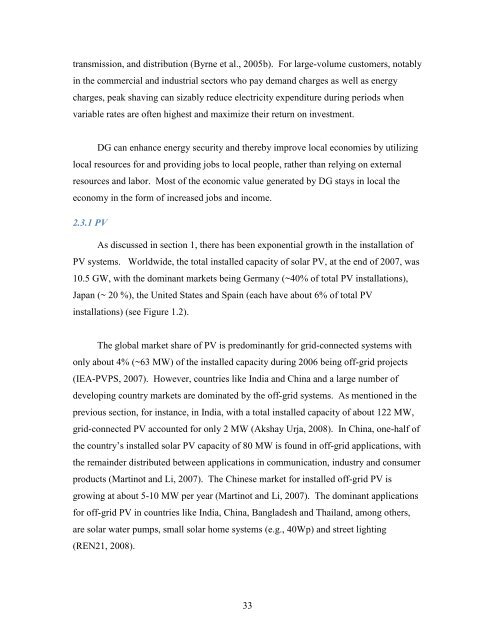review of solar energy technology, markets and policies - Center for ...
review of solar energy technology, markets and policies - Center for ...
review of solar energy technology, markets and policies - Center for ...
You also want an ePaper? Increase the reach of your titles
YUMPU automatically turns print PDFs into web optimized ePapers that Google loves.
transmission, <strong>and</strong> distribution (Byrne et al., 2005b). For large-volume customers, notably<br />
in the commercial <strong>and</strong> industrial sectors who pay dem<strong>and</strong> charges as well as <strong>energy</strong><br />
charges, peak shaving can sizably reduce electricity expenditure during periods when<br />
variable rates are <strong>of</strong>ten highest <strong>and</strong> maximize their return on investment.<br />
DG can enhance <strong>energy</strong> security <strong>and</strong> thereby improve local economies by utilizing<br />
local resources <strong>for</strong> <strong>and</strong> providing jobs to local people, rather than relying on external<br />
resources <strong>and</strong> labor. Most <strong>of</strong> the economic value generated by DG stays in local the<br />
economy in the <strong>for</strong>m <strong>of</strong> increased jobs <strong>and</strong> income.<br />
2.3.1 PV<br />
As discussed in section 1, there has been exponential growth in the installation <strong>of</strong><br />
PV systems. Worldwide, the total installed capacity <strong>of</strong> <strong>solar</strong> PV, at the end <strong>of</strong> 2007, was<br />
10.5 GW, with the dominant <strong>markets</strong> being Germany (~40% <strong>of</strong> total PV installations),<br />
Japan (~ 20 %), the United States <strong>and</strong> Spain (each have about 6% <strong>of</strong> total PV<br />
installations) (see Figure 1.2).<br />
The global market share <strong>of</strong> PV is predominantly <strong>for</strong> grid-connected systems with<br />
only about 4% (~63 MW) <strong>of</strong> the installed capacity during 2006 being <strong>of</strong>f-grid projects<br />
(IEA-PVPS, 2007). However, countries like India <strong>and</strong> China <strong>and</strong> a large number <strong>of</strong><br />
developing country <strong>markets</strong> are dominated by the <strong>of</strong>f-grid systems. As mentioned in the<br />
previous section, <strong>for</strong> instance, in India, with a total installed capacity <strong>of</strong> about 122 MW,<br />
grid-connected PV accounted <strong>for</strong> only 2 MW (Akshay Urja, 2008). In China, one-half <strong>of</strong><br />
the country‘s installed <strong>solar</strong> PV capacity <strong>of</strong> 80 MW is found in <strong>of</strong>f-grid applications, with<br />
the remainder distributed between applications in communication, industry <strong>and</strong> consumer<br />
products (Martinot <strong>and</strong> Li, 2007). The Chinese market <strong>for</strong> installed <strong>of</strong>f-grid PV is<br />
growing at about 5-10 MW per year (Martinot <strong>and</strong> Li, 2007). The dominant applications<br />
<strong>for</strong> <strong>of</strong>f-grid PV in countries like India, China, Bangladesh <strong>and</strong> Thail<strong>and</strong>, among others,<br />
are <strong>solar</strong> water pumps, small <strong>solar</strong> home systems (e.g., 40Wp) <strong>and</strong> street lighting<br />
(REN21, 2008).<br />
33


